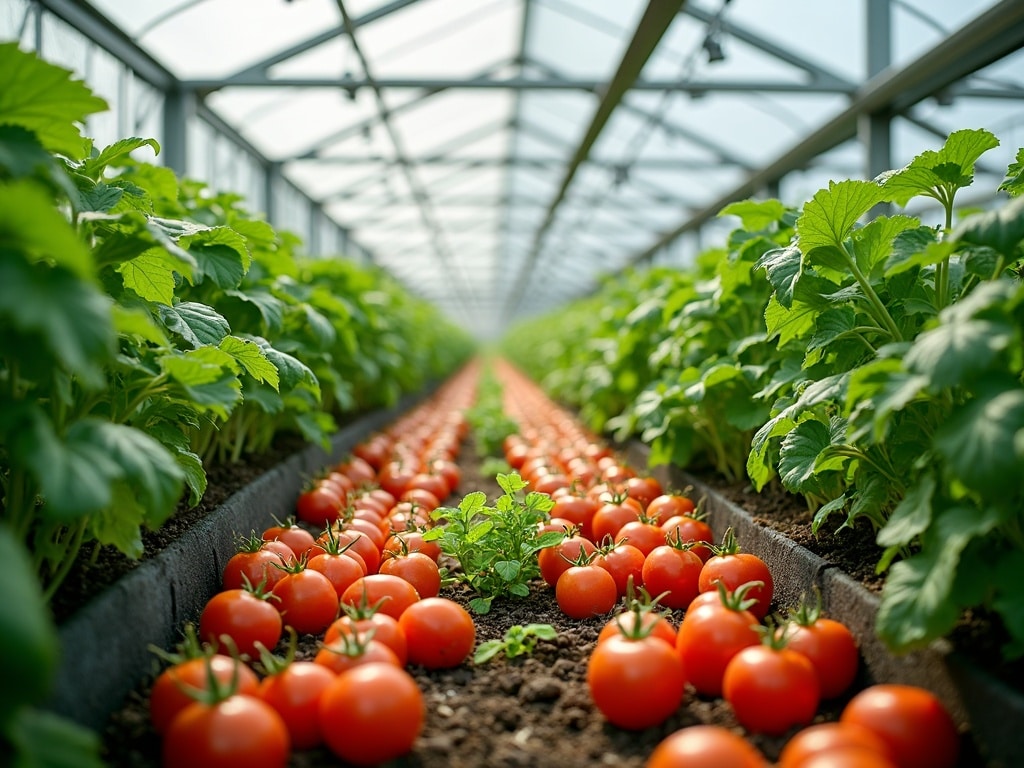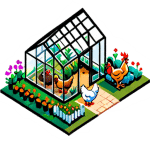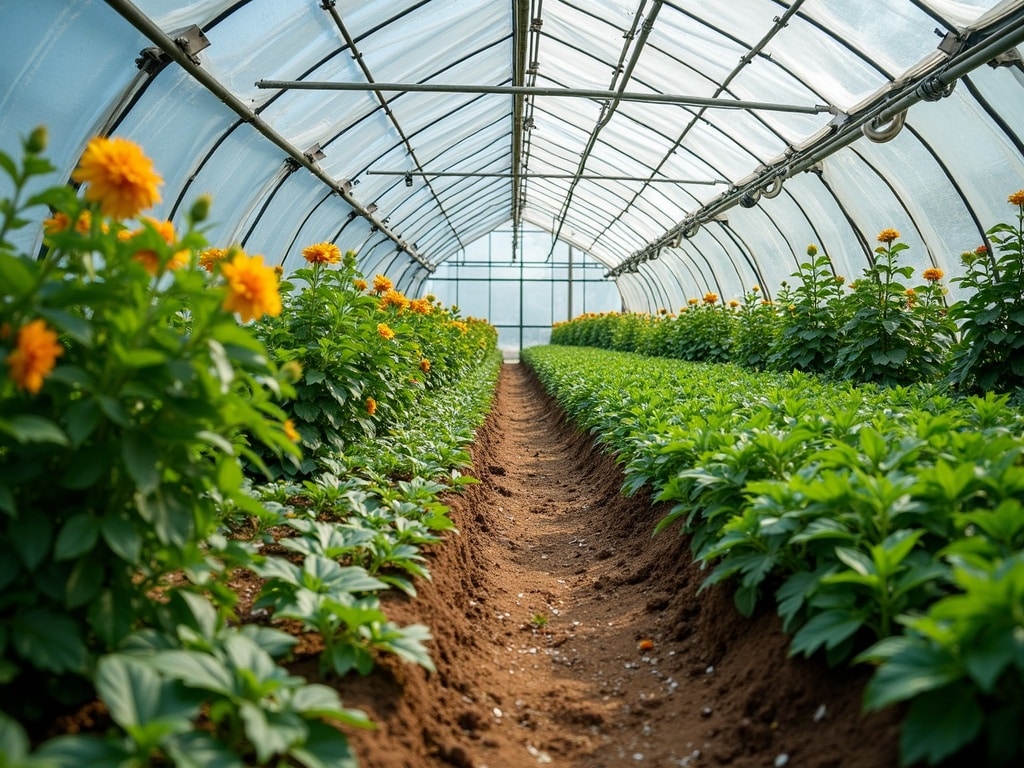Extending the Growing Season with a Greenhouse: A Comprehensive Guide
Imagine biting into a sun-ripened tomato in the dead of winter, or harvesting fresh herbs when the landscape is blanketed in snow. For gardeners in colder climates, this dream can become a reality. The secret? Harnessing the power of a greenhouse to extend the growing season. A greenhouse offers a protected environment where you can cultivate plants far beyond the limitations of your local climate, unlocking a continuous cycle of growth and harvest.
Why Extend the Growing Season? The Benefits of Greenhouse Gardening
Extending the growing season with a greenhouse isn't just about having fresh produce year-round; it's about maximizing your gardening potential and reaping a host of benefits:
**Year-Round Harvests:The most obvious benefit is the ability to grow fruits, vegetables, and herbs throughout the year, regardless of external weather conditions.
**Early Starts:Start seeds and seedlings weeks or even months before the last expected frost, giving your plants a head start and resulting in earlier harvests in the spring.
**Protection from the Elements:Greenhouses shield plants from harsh weather conditions such as frost, heavy rain, strong winds, hail, and extreme temperature fluctuations.
**Pest and Disease Control:A contained greenhouse environment allows for better control over pests and diseases, reducing the need for harmful chemicals.
**Exotic Plant Cultivation:Grow plants that wouldn't normally survive in your climate, expanding your gardening horizons and allowing you to experiment with exotic fruits, vegetables, and flowers.
**Increased Yields:The controlled environment of a greenhouse often leads to higher yields compared to outdoor gardening.
**Therapeutic Benefits:Gardening is a known stress reliever, and having a greenhouse provides a tranquil space to connect with nature year-round.
**Self-Sufficiency:Growing your own food reduces your reliance on grocery stores and contributes to a more sustainable lifestyle.
Understanding the Principles Behind Greenhouse Growing
Before diving into the specifics of extending the growing season with a greenhouse, it's crucial to understand the fundamental principles that make this possible:
**The Greenhouse Effect:Greenhouses work by trapping solar radiation. Sunlight passes through the transparent walls and roof, warming the interior. The structure then prevents much of the heat from escaping, creating a warmer environment than the outside.
**Temperature Regulation:Maintaining optimal temperatures is essential for plant growth. This involves both heating and cooling the greenhouse as needed.
**Light Management:Plants need adequate light for photosynthesis. Supplemental lighting may be required, especially during the shorter days of winter.
**Ventilation:Proper ventilation is crucial for regulating temperature, humidity, and air circulation, preventing the buildup of pests and diseases.
**Humidity Control:Maintaining appropriate humidity levels is vital for plant health. Too much humidity can lead to fungal diseases, while too little can cause stress and dehydration.
**Watering and Irrigation:Providing plants with the right amount of water is essential. Different plants have different watering needs, so it's important to understand the specific requirements of your crops.
**Soil and Nutrients:The quality of the soil or growing medium is crucial for plant growth. Ensure that your plants have access to the necessary nutrients through proper fertilization.
Choosing the Right Greenhouse for Extending Your Growing Season
Selecting the right greenhouse is a crucial first step in successfully extending your growing season. Consider the following factors:
**Size:Determine the amount of growing space you need based on the types and quantities of plants you plan to grow.
**Location:Choose a location that receives ample sunlight and is sheltered from strong winds. Consider the orientation of the greenhouse to maximize sunlight exposure.
**Type of Greenhouse:Different types of greenhouses are available, each with its own advantages and disadvantages:
**Hoop Houses (Quonset Greenhouses):These greenhouses are inexpensive and easy to build, but they may not be as durable as other types.
**Gable Greenhouses:These greenhouses have a traditional peaked roof and are well-suited for colder climates.
**Lean-to Greenhouses:These greenhouses are attached to an existing building and can save on heating costs.
**Geodesic Dome Greenhouses:These greenhouses are strong and energy-efficient, but they can be more complex to build.
**Glazing Material:The glazing material affects the amount of light that enters the greenhouse and its insulation properties:
**Glass:Glass is durable and provides excellent light transmission, but it can be expensive and heavy.
**Polycarbonate:Polycarbonate is lightweight, durable, and provides good insulation.
**Polyethylene Film:Polyethylene film is the least expensive option, but it is not as durable as other materials and needs to be replaced periodically.
**Frame Material:The frame material provides the structural support for the greenhouse:
**Wood:Wood is a traditional and aesthetically pleasing option, but it requires maintenance to prevent rot.
**Metal (Aluminum or Steel):Metal frames are durable and require little maintenance.
**PVC:PVC frames are inexpensive and easy to assemble, but they may not be as strong as other materials.
Essential Equipment for Greenhouse Growing
To effectively extend the growing season, you'll need a few key pieces of equipment:
**Heating System:A heating system is essential for maintaining optimal temperatures during the colder months. Options include:
**Electric Heaters:Electric heaters are easy to install and operate, but they can be expensive to run.
**Gas Heaters:Gas heaters are more efficient than electric heaters, but they require a gas line.
**Propane Heaters:Propane heaters are portable and can be used in greenhouses without a gas line.
**Wood Stoves:Wood stoves can be a cost-effective option if you have access to a source of wood.
**Ventilation System:A ventilation system is crucial for regulating temperature, humidity, and air circulation. Options include:
**Roof Vents:Roof vents allow hot air to escape from the top of the greenhouse.
**Side Vents:Side vents allow for cross-ventilation.
**Exhaust Fans:Exhaust fans help to remove hot air and humidity.
**Circulation Fans:Circulation fans help to distribute air evenly throughout the greenhouse.
**Shading System:A shading system is needed to protect plants from excessive sunlight during the summer months. Options include:
**Shade Cloth:Shade cloth is a mesh fabric that reduces the amount of sunlight entering the greenhouse.
**White Wash:White wash is a paint-like substance that can be applied to the glazing material to reflect sunlight.
**Retractable Shade Systems:Retractable shade systems allow you to adjust the amount of shading as needed.
**Lighting System:Supplemental lighting may be required, especially during the shorter days of winter:
**LED Grow Lights:LED grow lights are energy-efficient and provide the full spectrum of light needed for plant growth.
**Fluorescent Grow Lights:Fluorescent grow lights are less expensive than LED grow lights, but they are not as energy-efficient.
**High-Pressure Sodium (HPS) Grow Lights:HPS grow lights are very efficient, but they produce a lot of heat.
**Watering System:Choose a watering system that suits your needs and the types of plants you are growing:
**Hand Watering:Hand watering is suitable for small greenhouses.
**Drip Irrigation:Drip irrigation delivers water directly to the roots of plants, reducing water waste.
**Sprinkler Systems:Sprinkler systems are easy to install, but they can waste water.
**Climate Control System:A climate control system automates the regulation of temperature, humidity, and ventilation, making it easier to maintain optimal growing conditions.
Planning Your Extended Growing Season: What to Grow When
The key to successfully extending the growing season is to plan your crops carefully, considering the specific climate conditions and the capabilities of your greenhouse. Here's a general guideline of what to grow when:
**Late Winter/Early Spring (Starting Indoors in the Greenhouse):**
**Vegetables:Start seeds for tomatoes, peppers, eggplants, broccoli, cauliflower, cabbage, lettuce, spinach, and herbs indoors in the greenhouse. This allows you to get a head start on the growing season and transplant seedlings outdoors once the weather warms up.
**Flowers:Start seeds for annual flowers such as petunias, marigolds, and zinnias indoors in the greenhouse.
**Spring (Greenhouse and Outdoor Planting):**
**Vegetables:Transplant seedlings of tomatoes, peppers, eggplants, broccoli, cauliflower, and cabbage outdoors once the risk of frost has passed. Continue to grow lettuce, spinach, and herbs in the greenhouse.
**Flowers:Transplant seedlings of annual flowers outdoors. Start seeds for summer-blooming flowers such as sunflowers and cosmos directly in the garden.
**Summer (Greenhouse and Outdoor Harvesting):**
**Vegetables:Harvest tomatoes, peppers, eggplants, cucumbers, beans, and other summer vegetables from your outdoor garden. Continue to grow lettuce, spinach, and herbs in the greenhouse.
**Flowers:Enjoy the blooms of your summer flowers. Deadhead spent flowers to encourage continued blooming.
**Fall (Extending the Season in the Greenhouse):**
**Vegetables:Plant cool-season crops such as lettuce, spinach, kale, Swiss chard, and radishes in the greenhouse. These crops will thrive in the cooler temperatures and provide a continuous harvest throughout the fall and winter.
**Flowers:Plant mums and other fall-blooming flowers in the greenhouse for a splash of color.
**Winter (Year-Round Growing in the Greenhouse):**
**Vegetables:Continue to harvest lettuce, spinach, kale, Swiss chard, and radishes from the greenhouse. Consider growing other winter vegetables such as carrots, beets, and turnips.
**Herbs:Grow a variety of herbs in the greenhouse, such as parsley, chives, thyme, oregano, and rosemary. These herbs will add flavor to your winter meals.

Tips for Maximizing Your Greenhouse's Potential
**Maintain Optimal Temperatures:Use a thermometer to monitor the temperature inside the greenhouse and adjust the heating and ventilation systems as needed.
**Provide Adequate Light:Ensure that plants receive adequate light, especially during the shorter days of winter. Use supplemental lighting if necessary.
**Control Humidity:Maintain appropriate humidity levels to prevent fungal diseases. Use a dehumidifier or increase ventilation if humidity levels are too high.
**Water Regularly:Water plants regularly, but avoid overwatering. Allow the soil to dry out slightly between waterings.
**Fertilize Properly:Fertilize plants regularly with a balanced fertilizer.
**Practice Good Hygiene:Keep the greenhouse clean and free of debris to prevent pests and diseases.
**Monitor for Pests and Diseases:Regularly inspect plants for signs of pests and diseases. Take action promptly to control any problems that arise.
**Rotate Crops:Rotate crops regularly to prevent the buildup of soilborne pests and diseases.
**Use Companion Planting:Plant companion plants together to deter pests, attract beneficial insects, and improve plant growth.
**Insulate Your Greenhouse:Properly insulate your greenhouse to conserve energy and reduce heating costs.
**Automate Tasks:Invest in a climate control system to automate tasks such as temperature regulation, ventilation, and watering.
Specific Crops for Year-Round Greenhouse Growing
Here are some specific crop suggestions tailored for year-round greenhouse cultivation:
**Lettuce:A cool-season crop that thrives in the greenhouse. Choose loose-leaf varieties for continuous harvesting.
**Spinach:Another cool-season favorite, spinach is easy to grow and packed with nutrients.
**Kale:A hardy and nutritious leafy green that can withstand cooler temperatures.
**Swiss Chard:A colorful and versatile leafy green that adds a touch of elegance to your winter garden.
**Radishes:Quick-growing and easy to cultivate, radishes provide a spicy addition to salads and snacks.
**Carrots:Plant carrot seeds in the fall for a winter harvest. Choose shorter varieties that are well-suited for container growing.
**Beets:Similar to carrots, beets can be planted in the fall for a winter harvest.
**Turnips:A versatile root vegetable that can be grown for its roots or its greens.
**Herbs:A wide variety of herbs can be grown in the greenhouse year-round, including parsley, chives, thyme, oregano, rosemary, basil, and mint.
**Tomatoes:With proper heating and lighting, you can grow tomatoes in the greenhouse year-round. Choose determinate varieties that are well-suited for container growing.
**Peppers:Similar to tomatoes, peppers can be grown in the greenhouse year-round with proper heating and lighting.
**Strawberries:Extend your strawberry season by growing them in the greenhouse.
Troubleshooting Common Greenhouse Problems
Even with careful planning and execution, you may encounter challenges when extending the growing season with a greenhouse. Here's a guide to troubleshooting common problems:
**Temperature Fluctuations:**
**Problem:Wide temperature swings can stress plants and hinder growth.
**Solution:Ensure adequate insulation, use a reliable heating system, and implement a ventilation system to regulate temperature. Consider a climate control system for automated temperature management.
**High Humidity:**
**Problem:Excessive humidity can lead to fungal diseases such as powdery mildew and gray mold.
**Solution:Improve ventilation by opening vents or using exhaust fans. Use a dehumidifier if necessary. Water plants in the morning so that foliage has time to dry before nightfall.
**Low Humidity:**
**Problem:Insufficient humidity can cause plant stress, dehydration, and stunted growth.
**Solution:Increase humidity by misting plants, using a humidifier, or placing trays of water near plants.
**Pests:**
**Problem:Common greenhouse pests include aphids, whiteflies, spider mites, and thrips.
**Solution:Inspect plants regularly for signs of pests. Introduce beneficial insects such as ladybugs and lacewings to control pest populations. Use insecticidal soap or neem oil to treat infestations.
**Diseases:**
**Problem:Common greenhouse diseases include fungal diseases, bacterial diseases, and viral diseases.
**Solution:Practice good hygiene to prevent the spread of diseases. Provide adequate ventilation to reduce humidity. Use disease-resistant varieties of plants. Treat diseases with appropriate fungicides or bactericides.
**Insufficient Light:**
**Problem:Lack of adequate light can cause leggy growth, reduced flowering, and poor yields.
**Solution:Provide supplemental lighting with LED grow lights or fluorescent grow lights. Clean the glazing material regularly to maximize light transmission.
**Nutrient Deficiencies:**
**Problem:Plants may exhibit signs of nutrient deficiencies such as yellowing leaves, stunted growth, or poor flowering.
**Solution:Fertilize plants regularly with a balanced fertilizer. Conduct a soil test to determine if any specific nutrients are lacking. Amend the soil with appropriate nutrients as needed.
**Algae Growth:**
**Problem:Algae can grow on the glazing material, reducing light transmission and creating a slippery surface.
**Solution:Clean the glazing material regularly with a mild soap and water solution. Use an algaecide to prevent algae growth.
The Future of Greenhouse Growing: Innovations and Trends
The field of greenhouse growing is constantly evolving, with new innovations and trends emerging all the time. Here are a few to watch:
**Vertical Farming:Vertical farming involves growing crops in stacked layers, maximizing space and yield in urban environments.
**Hydroponics and Aquaponics:These soilless growing methods are becoming increasingly popular in greenhouses. Hydroponics involves growing plants in nutrient-rich water solutions, while aquaponics combines hydroponics with aquaculture, raising fish and using their waste to fertilize plants.
**LED Lighting Technology:LED lighting is becoming more energy-efficient and affordable, making it an increasingly attractive option for supplemental lighting in greenhouses.
**Automation and Robotics:Automation and robotics are being used to automate tasks such as watering, fertilizing, and harvesting, reducing labor costs and improving efficiency.
**Data Analytics and Artificial Intelligence:Data analytics and artificial intelligence are being used to monitor and optimize greenhouse conditions, improving yields and reducing resource consumption.
**Sustainable Greenhouse Practices:There is a growing emphasis on sustainable greenhouse practices, such as using renewable energy sources, conserving water, and reducing waste.
Extending the growing season with a greenhouse is a rewarding endeavor that can provide you with fresh produce year-round. By understanding the principles of greenhouse growing, choosing the right greenhouse and equipment, planning your crops carefully, and troubleshooting common problems, you can unlock the full potential of your greenhouse and enjoy a continuous cycle of growth and harvest. Embrace the future of gardening and savor the taste of homegrown goodness, no matter the season.

